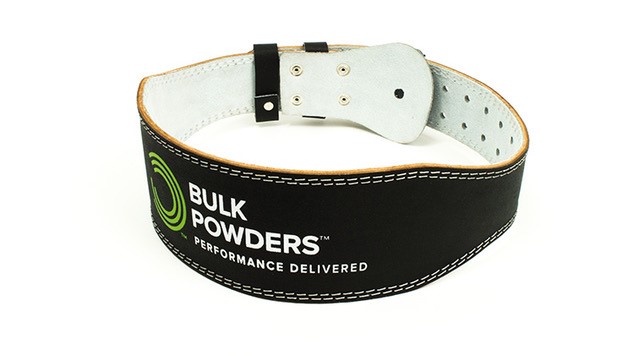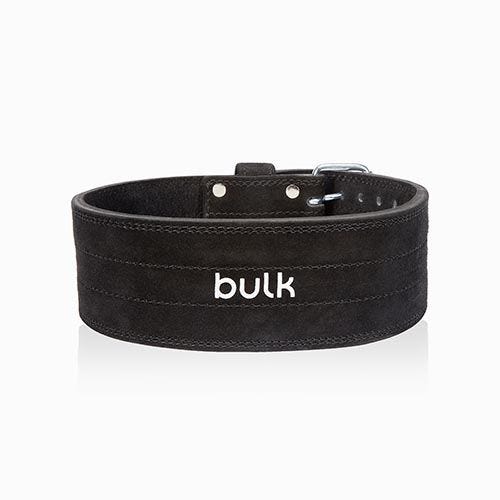Weightlifting belts are, without exception, probably the most incorrectly used piece of fitness accessory equipment. This largely comes from a misunderstanding about the reason as to why weightlifting belts are used, particularly in strength sports like powerlifting or weightlifting.
Many people use lever lifting belts to strap themselves in tight and to almost try to support the body by directly compressing the body together. The problem with treating a weightlifting belt like a brace or back support, is that this is not actually what a belt is designed to do.
Although many bodybuilders or regular gym goers might use a belt for this extra internal support, this can often be problematic and lead to laziness in activation of the core and lower back muscles, which may actually increase risk of injury in the long term.
Some people might argue that using a weightlifting belt keeps the waistline tighter by not recruiting the muscles of the core forcing them to grow… however, as we will see, a properly used weightlifting belt should be used for the exact opposite reason.
What does a lifting belt actually do?
Contrary to popularly held beliefs, a properly used weightlifting belt actually increases core activation by allowing you something to brace against.
By ‘forcing’ air into our lower abdomen and creating pressure to brace against the belt, we create what is known as intra-abdominal pressure. This pressure creates stability around the midsection and the spine and, if performed correctly, increases core activation. This is exactly what they are designed to do.
What are the Benefits of Using a Lifting Belt?
The main benefit of a correctly used belt is the capacity to lift more weight safely! If that’s not a big enough benefit to using a lifting belt, then what is!
Before using a belt, it is probably a good idea to learn how to brace correctly without one. To do this, lay flat on the floor and put your hands on your waist so that the inside ridge of your hand, from the tip of your index finger to the tip of your thumb, presses into your sides.
Take a deep breath, and hold it, forcing the air down into your lower abdomen. The important thing here though is to not crunch and tense the abdominal muscles, but more to push the stomach and hip muscles outwards.
This should mean your hands are now being pushed away and that underneath the skin becomes solid with no major ‘give’ compared to the relaxed state.
Developing this technique should mean that when using a belt, you should create excellent stability. It does also mean that when lifting heavy you need to allow enough time between repetitions, to breath, re-brace and reset before the next rep. Breathing is kind of important after all!
Who should use a weight lifting belt?
You don’t have to be a competitive powerlifter or bodybuilder to get the benefits of a weightlifting belt as long as you are using it correctly! Anyone who lifts heavy, especially the big lifts like the squat and deadlift can often get some benefit from using a belt.
However, you don’t necessarily have to use a belt. If you are performing lots of reps where you want to keep tension on the main moving muscles, perhaps not having to fully brace might be an advantage in terms of breathing. Especially if not pausing between repetitions.
This means for most bodybuilding movements at higher repetition ranges and lower weights, we can get away without using a belt as long as we can also engage the muscles of our core and lower back correctly as the load should not be a problem to handle. This comes with making sure we are in a correct body position and using solid technique, which is sufficient at lighter loads without the need to brace strongly.
When should you not use a belt?
Some people like to use a belt for all manner of exercises and there is no real right time to use one as long as they are being used correctly and for the right purpose. Even competitive powerlifters may use a belt when doing pressing exercises like bench press as it allows them to create a stable platform.
It is important to note that a belt should not be used to compensate for injury or poor technique. It is a belt, not a back support or movement crutch! This means, if suffering a back injury, your priority should be on rehabilitation and not trying to compensate with a belt.
It is a good idea for a beginner to develop good lifting technique without the need for a belt, so belts do not become a reason to develop poor technique and core control. This will only get you so far before using a belt ‘lazily’ might put you at risk of injury, not reduce it.
What type of belt should I choose?
Bodybuilding style weight training belts tend to be narrower at the front with a wider region at the back, made of fairly soft leather. This is because they are primarily designed to offer extra support and are not really ideal for bracing properly as we have described above.
Bodybuilding style belts are most often used to provide a safety net for when the core muscles become fatigued at the higher rep ranges bodybuilders train to provide extra protection.
Whether this is a good or bad thing is often debated. My opinion is, if using a belt, it should mostly be used for heavy lifting and be an active component of every rep to brace, not simply a safety net in case things go wrong.
Powerlifting belts are mostly made from a much stiffer, thicker leather, which is uniform width all the way around the belt. This provides equal amounts of support around the core and something firm to brace against to maximise core activation and create a more stable spine and stronger lift.
Related articles
Looking to learn more? We believe that every person, with support, has the right to transform their lives through fitness. That’s why we’ve put together hundreds of articles with expert advice, all to help you on your fitness journey. Here are more articles on gym training accessories, including lifting straps, wrist wraps and knee wraps.
How to use lifting straps Best gym and training accessories
How to use wrist wraps Gym bag essentials
Advanced fitness training methods How can knee wraps support your lifting?
A guide to the different Bulk ranges Why is good gym clothing important?
Hygiene and cleanliness at Bulk Why should you use kettlebells?











